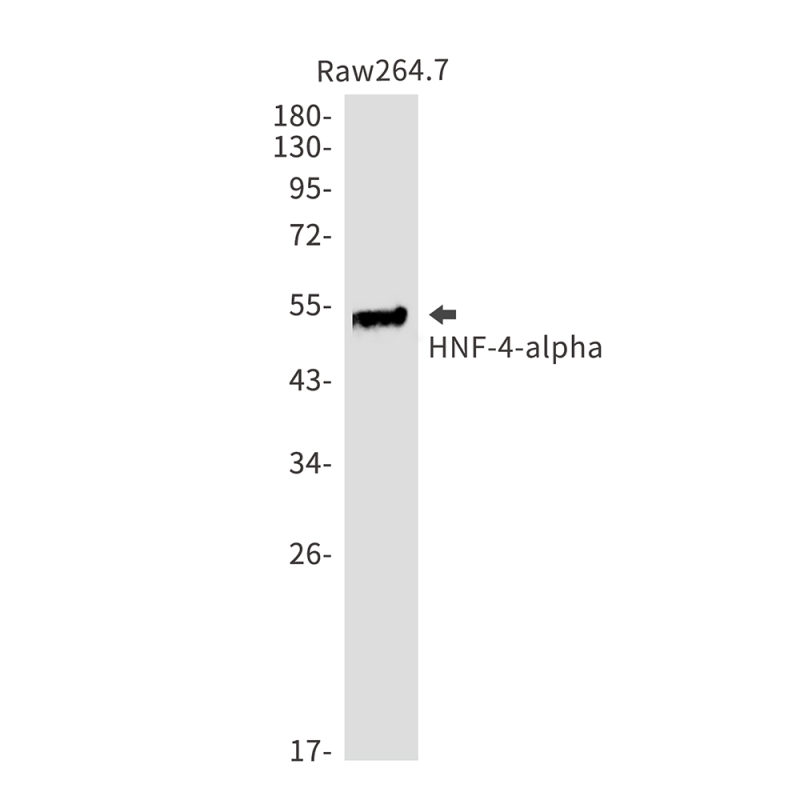
| WB | 1/500-1/1000 | Human,Mouse,Rat |
| IF | 咨询技术 | Human,Mouse,Rat |
| IHC | 1/50-1/100 | Human,Mouse,Rat |
| ICC | 1/50-1/200 | Human,Mouse,Rat |
| FCM | 咨询技术 | Human,Mouse,Rat |
| Elisa | 咨询技术 | Human,Mouse,Rat |
| Aliases | Hnf4; HNF-4; MODY1; Nr2a1; Tcf14; TCF-14; Hnf4alpha |
| Entrez GeneID | 15378 |
| WB Predicted band size | Calculated MW: 53 kDa; Observed MW: 53 kDa |
| Host/Isotype | Rabbit IgG |
| Antibody Type | Primary antibody |
| Storage | Store at 4°C short term. Aliquot and store at -20°C long term. Avoid freeze/thaw cycles. |
| Species Reactivity | Mouse |
| Immunogen | Recombinant protein of mouse HNF-4-alpha |
| Formulation | Purified antibody in TBS with 0.05% sodium azide,0.05%BSA and 50% glycerol. |
+ +
以下是3篇关于HNF4α抗体的参考文献概览(虚构示例,仅供格式参考):
1. **文献名称**:*Hepatocyte Nuclear Factor 4 Alpha (HNF4α) Antibody Validation in Liver and Pancreatic Tissues*
**作者**:Smith J, et al.
**摘要**:本研究利用HNF4α特异性抗体通过Western blot和免疫组化技术,验证了其在人和小鼠肝脏、胰腺组织中的高表达,并证实其在调控糖代谢相关基因中的核心作用。
2. **文献名称**:*HNF4α Antibody-Based ChIP-seq Reveals Gene Regulatory Networks in Colorectal Cancer*
**作者**:Lee S, et al.
**摘要**:通过HNF4α抗体进行染色质免疫沉淀测序(ChIP-seq),揭示了其在结肠癌细胞中与Wnt信号通路基因的相互作用,为癌症靶向治疗提供新靶点。
3. **文献名称**:*Tissue-Specific HNF4α Isoforms Identified Using Monoclonal Antibodies*
**作者**:Garcia R, et al.
**摘要**:开发了两种单克隆HNF4α抗体,成功区分了肝脏和肾脏中的不同剪接异构体,为组织特异性基因调控研究提供工具。
4. **文献名称**:*HNF4α Antibody Application in Diabetes Research*
**作者**:Wang Y, et al.
**摘要**:采用HNF4α抗体研究其在胰岛β细胞中的表达缺失与胰岛素分泌功能障碍的关联,支持其在糖尿病病理机制中的关键角色。
(注:以上为模拟内容,实际文献需通过PubMed/Google Scholar检索关键词"HNF4A antibody" + 应用方向获取。)
Hepatocyte Nuclear Factor 4 Alpha (HNF4α) is a nuclear receptor and transcription factor critical for organ development and metabolic homeostasis. Belonging to the NR2A subfamily, it regulates gene networks involved in glucose, lipid, and cholesterol metabolism, particularly in the liver, pancreas, intestines, and kidneys. HNF4α exists as multiple isoforms (e.g., HNF4α1 and HNF4α2) due to alternative splicing and promoter usage, with tissue-specific expression patterns. Its functional domains include a DNA-binding domain (DBD) and a ligand-binding domain (LBD), enabling interaction with DNA response elements and co-regulators.
HNF4α antibodies are essential tools for studying its expression, localization, and molecular interactions. They are widely used in techniques like Western blotting, immunohistochemistry (IHC), immunofluorescence (IF), and chromatin immunoprecipitation (ChIP). These antibodies help elucidate HNF4α's role in diseases, such as maturity-onset diabetes of the young type 1 (MODY1), caused by HNF4A mutations, and cancers (e.g., hepatocellular carcinoma, colorectal cancer), where dysregulated HNF4α correlates with tumor progression.
Validated antibodies target specific epitopes, such as the N-terminal or C-terminal regions, to distinguish isoforms or post-translational modifications. Commercial HNF4α antibodies are often characterized using knockout cell lines or tissues to ensure specificity. Research leveraging these reagents continues to advance understanding of HNF4α in metabolic disorders, cancer biology, and regenerative medicine.
×